TENERIFE
Plants and Animals
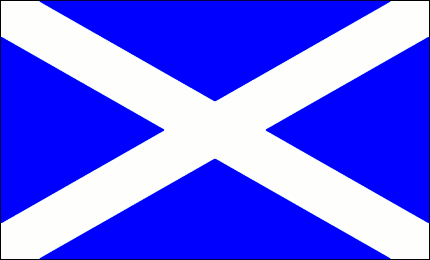
Plants and Animals
Cities in TENERIFE
| Costa adeje | Los cristianos | Playa de las americas |
Popular destinations SPAIN
| Andalusia | Catalonia | Costa blanca |
| Costa brava | Costa del sol | El hierro |
| Formentera | Fuerteventura | Gran canaria |
| Ibiza | La gomera | La palma |
| Lanzarote | Mallorca | Menorca |
| Tenerife |
Plants and Animals
Plants
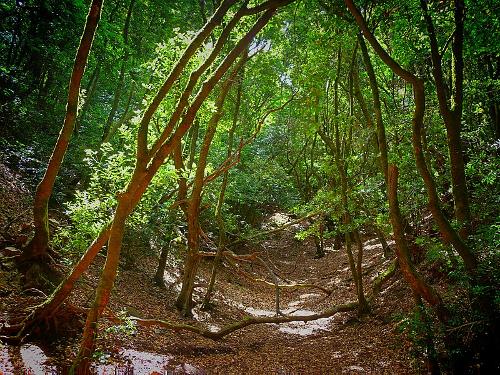 Laurisilva forest TenerifePhoto: Xavi CC 2.0 Generic no changes made
Laurisilva forest TenerifePhoto: Xavi CC 2.0 Generic no changes made
Of the 1650 plant, flower and tree species occurring in the Canary Islands around 600 are indigenous. Of these 600 there are hundreds that occur on only one island, often even in a single ravine. Due to its isolated location, there are still flowers, trees and plants that have been extinct in the rest of the world for 2.5 million years. An example are the "laurasilva" forests, which used to be found in large parts of Africa and Europe, but now only in the Canary Islands (Tenerife: Monte de los Mercedez in the Anaga mountains). Characteristic of this forest are the laurel trees with their unusual small leaves, the winding trunks and the mossy soil on which they grow. In the forest survived plant species that have become extinct in the rest of the world since the first Ice Age. The forest is located in a shrubby plant formation called "fayal-brezal", whose most characteristic plants are myrtle and heather.
Three vegetation zones can be distinguished on the Canary Islands. The dry zone up to approx. 900 meters altitude is home to cacti, disc) cacti, native date palms, acacias, almond trees, mimosa, jacarandas, Canarian cedars, agaves, banana plants, sugar cane, Canarian lavender, aloe and eucalyptus trees.
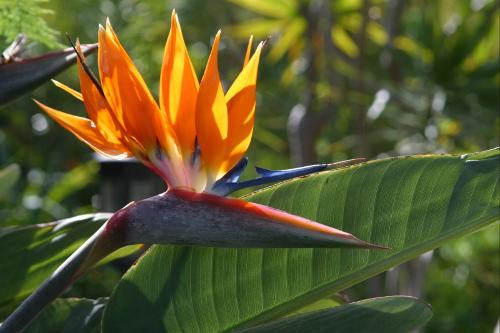 Strelitzia (bird of paradise flower) is Tenerife's national flowerPhoto: bildtankstelle.de in the public domain
Strelitzia (bird of paradise flower) is Tenerife's national flowerPhoto: bildtankstelle.de in the public domain
The strelitzia or paradise flower is the national flower of Tenerife. In the arid regions you will find the candelabra spurge (cardón) and the king juba spurge or "tabaiba". The thickened juice of the tabaiba can be eaten as a kind of chewing gum. The juice of another spurge, the "cardó" or candlestick cactus, mixed with oil, is used as a medicine. The "Tajinaste" is a stocky shrub with a sausage-like trunk and fine green leaves.
The plantations with the small Chinese banana or dwarf banana grow between 300-400 meters above sea level. The Tajinaste plant is a very special flower that initially only occurred on Tenerife, but has now also been successfully planted in Gran Canaria. The crop can reach a height of almost two meters and tens of thousands of red flowers can grow on one plant. The Canarian palm (Phoenix canariensis) can be found everywhere, resembles the North African date palm, but is shorter, with large lush leaves and a more beautiful crown. The colorful poinsettia grows to the size of a tree in Tenerife.
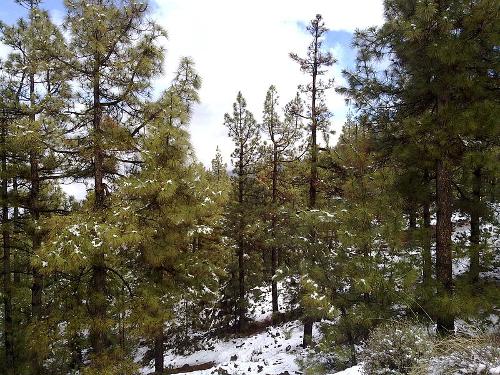 Canary Pines, TenerifePhoto: Kallerna in the public domain
Canary Pines, TenerifePhoto: Kallerna in the public domain
The tree zone (up to 1800 meters) contains different types of coniferous and deciduous trees, including different laurel species, holly, tree heather and the Canary pine trees (pino canario or Latin: Pinus canariensis), which can reach 20-30 meters in height. In the pine forests (the largest forest is the pine forest of Tamadaba), among other things, the rock rose and the sleeping lily grow. The "tuno indio", a wild growing cactus species, has many sharp spines and small, red fruits, which are very sweet but very refreshing.
Dwarf shrubs, lichens and many herbs grow in the mountain zone (above 1800 meters). In winter, the Teide daisy blooms in the Las Cañaras National Area, in May the same area is covered with white and purple Teide broom flowers. The purple-colored Teide violet, one of the few plant species that still grows above 3,500 meters, blooms around the top of Mount Teide.
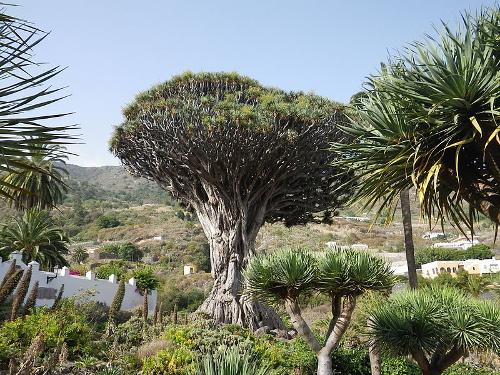 Canary Dragon Tree, TenerifePhoto: Robur.q CC 3.0 Unported no changes made
Canary Dragon Tree, TenerifePhoto: Robur.q CC 3.0 Unported no changes made
The most famous tree in the Canary Islands is the Canarian dragon tree (Dracaena draco) or dragon blood tree, which belongs to the lilies families and is related to the yuccas. The latter name is due to the dark red resin of this rare tree. This Canary variety, which can live for several hundred years to perhaps thousands of years, is only found in the Cape Verde Islands and Madeira, and has been extinct elsewhere for more than twenty million years. The oldest dragon tree in Tenerife and the Canary Islands, "El Drago", is about 700 years old and is located in the town of Icod de los Vinos. The tree is over 16 meters high, weighs about 140 tons, has a diameter of 20 meters and a circumference of 6 meters.
The dragon tree occupied an important place in the distant past in the life of the Guanches, the original inhabitants of the Canary Islands. The main product was the "dragon's blood", which was used, among other things, as a medicine.
Animals
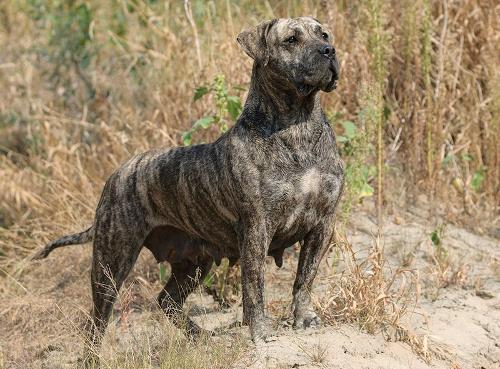 Perra de Presa Canario TenerifePhoto: Smok Brazily CC 4.0 International no changes made
Perra de Presa Canario TenerifePhoto: Smok Brazily CC 4.0 International no changes made
Compared to the plant world, the animal world is much smaller in terms of species diversity on the Canary Islands. Some special native species are the Teidevink, the Canarian kestrel, the brown canary and the laurel and pine pigeon. The Canary Islands are not named after this canary, but the birds are named after the Canary Islands. The Canary Islands get their name from the Perra de Presa Canario, a large dog species that was already present on the islands during the Roman times.
Common bird species include partridges, ravens, woodpeckers, thrushes, buzzards and kestrels.
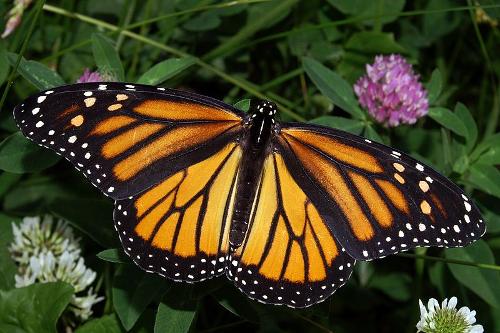 Monarch Butterfly, TenerifePhoto: Kenneth Dwain Harrelson CC 3.0 Unported no changes made
Monarch Butterfly, TenerifePhoto: Kenneth Dwain Harrelson CC 3.0 Unported no changes made
Well-known butterfly species are the red monarch butterfly, the blue Canary butterfly, the orange tiger butterfly and the red-black colored lady.
Of the four lizard species, three are endemic to the Canary Islands: the Canary lizard, the Canary gecko, and the Canary skink. The fourth species, the Turkish gecko, has only just arrived in Tenerife. Snakes do not occur on the island, but frogs do; two species, the large swamp frog and the smaller striped tree frog. Scorpions have also been sighted recently, probably entering the port of Santa Cruz.
Wild mammals include rabbits, hares, rats, mice and some scattered mouflons. There are three species of bats in Tenerife, of which the Canary long-eared bat is only found in the Canary Islands.
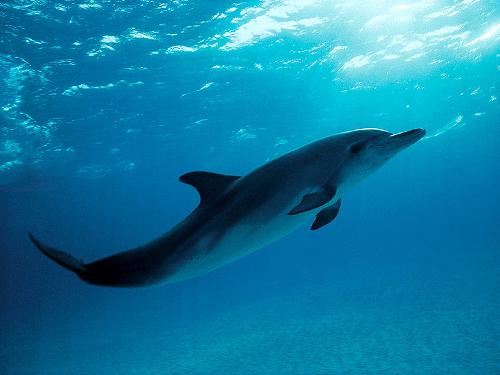 Dolphin, TenerifePhoto: Sheilapic76 CC2.0 Generic no changes made
Dolphin, TenerifePhoto: Sheilapic76 CC2.0 Generic no changes made
The seas around Tenerife include: swordfish, salmon, sea turtles, shark species, sailfish, lobsters, goldfish, anglerfish, heken, sole, crawfish, sea bass, dolphins, tuna, mackerel, lemon fish, squid and marlins. Groups of killer whales and other whale species can also be found around the island.
Sources
Gruschwitz, B.F. / Canarische Eilanden
Het Spectrum
Klöcker, H. / Tenerife
Zuidnederlandse Uitgeverij
Krause, D. / Tenerife
ANWB,
Nowaczyk, D. / Tenerife
Van Reemst
Rokebrand, R. / Reishandboek Tenerife
Elmar
CIA - World Factbook
BBC - Country Profiles
Copyright: Team The World of Info